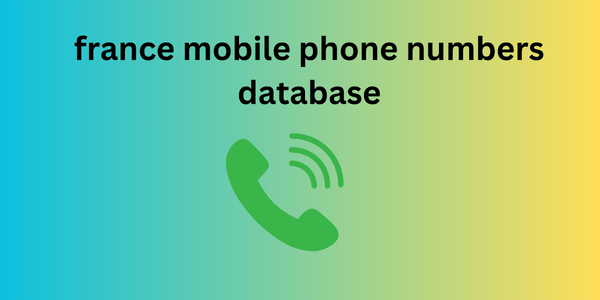Engaging visual content can change the way your users perceive your brand. It’s no coincidence that tech giants around the world are experimenting with reels. Even before reels came along, brands like Pinterest were all the rage with visually rich, engaging boards filled with great content.
Fast forward to today, and brands are preparing to make major investments in generative artificial intelligence to create visuals that will guide their marketing strategies.
With the rise of social media france mobile phone numbers database brands have no alternative but to add visual content to their marketing strategies.
And it's not just static images.
The Power of Visual Content in Marketing
You want to create a brand association with your marketing campaigns, and visuals are a great way to do that. In fact, marketers are more positive than ever about visuals driving better conversions.
The power of visual content is in getting it right. If you’re not telling a story that will resonate with your audience, you’ve defeated the entire reason for creating a visual. Whether you’re using static images, infographics, or a reel, you need to have a story, some facts, and useful information to tell your users.
Storytelling is a great way to get your message across to your users. Not only does it create emotional arousal, it also helps build a long-term user-brand relationship. Good visuals can turn your users into brand evangelists, which is a big win for any brand.
For example, if you follow Figma’s LinkedIn Page, you’ll see small how-to videos and images about the new features that are visual guides for using the tools. For example, this guide shows how to create glossy icons in Figma.

how to create glossy icons on Figma - Figma
Source: Figma's LinkedIn Page
There are many examples of users sharing videos of themselves creating amazing graphics using the tool.
How are you using the new variables in Figma
Source: Figma's LinkedIn Page
Three things are happening here -
Users learn how to use a particular feature in real time
Users continually return to these videos when using the features
New users are amazed by the possibilities the tool offers and start trying it out.
This is how you get engagement, retention, returning users, and new users.
Are images and videos the only types of visual content?
While images and videos epitomize all types of visual content marketers use, different forms of visual content include:
e-books
Motion graphics
Infographics
Explainer videos
Data visualization
Annual reports
Landing pages
Visual CTA
Memes
Product screenshots
GIFs
Illustrations and comics
PPTs; and more
Tips for Using Visual Content in Marketing
Studies show that the human brain can process images almost 60,000 times faster than text, and 90% of the information it processes is visual. If you include this criterion in your marketing, most of your text will be ignored. Your users will always prefer to watch cute dog videos than read about the growth stages of a puppy.
After all, information conveyed through visuals is remembered longer. In short, 20% of what you market gets read, and 20% of that 20% gets remembered. Wow!
Images can drive traffic, but you have to do it yourself. Marketers need help finding the right balance between images and content, which makes the job even more challenging .
Below are a few tips (tried and tested) that you should incorporate when designing your next piece of visual content.
Create a story with visuals
Your target audience wants to hear your story in a way that grabs their attention. As a marketer, you want to tell a story that:
Connecting with your target audience
Gives all the information quickly
Triggers loyalty
Leaves a lasting impression
When creating your marketing strategy, you should plan your visuals to do all four of the things listed above, like the Walmart Yard Management System (YMS) does with this whiteboard explainer video.
This 2 minute 25 second video may seem long, but the synchronization of the animations and the narration provide a coherent guide for anyone looking to understand how the system works.
It talks about the problems the system solves and shows exactly how it solves them. This is a story created to fully explain the use case the brand is based on.
This is a classic example of convincing new audiences to go ahead and explore the system because it speaks to the problem statement (which resonates with target users) and the solution (which is exactly what users are looking for). Bingo!
Align your visuals with your marketing strategy
This is a giver. Your visuals and marketing ideas should be in sync. When creating copy for your marketing campaign, your image should also be in sync with the text. Not just the text, your visuals should align with your brand identity (colors, website copy, landing pages, social channels) and expand on your value proposition (your brand’s unique offering).
